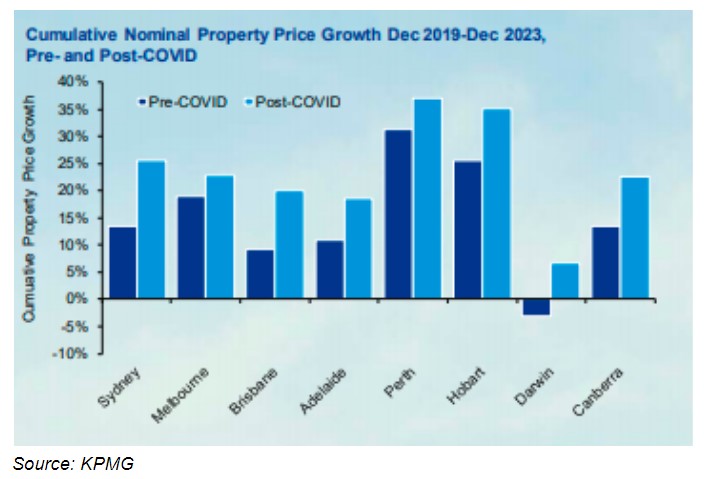Australia’s property prices have increased much higher than what the market would have seen if the Covid-19 pandemic didn’t exist.

Government policy responses and property market support, such as lowered cash rates and the HomeBuilder program, to help alleviate pressure from the Covid-19 outbreak, combined with a material decline in mortgage interest rates, has seen prices rise dramatically in the past 6-9 months.
This increase, the report explains, has caused a rise in residential property prices greater than what would have occurred in a no-Covid-19 scenario.
It appears the short-term positive factors of lower mortgage interest rates have swamped the longer-term negative factors of lower population and price disequilibrium during this recent price spike,” the report said.
“However, residential property price growth is expected to temper over the next 2 to 3 years as lower population growth, a reversion back to equilibrium and higher mortgage lending rates weigh on property prices.”
Notwithstanding this moderating property price growth during 2022 and 2023, KPMG’s analysis shows that house prices are expected to be 4-12% higher and unit values are expected to be 0-13% higher than would have been the case in the absence of Covid-19.
Covid-19 vs no-Covid-19: What property prices would have been
According to KPMG’s modeling, without the pandemic, house prices in Sydney would have risen 13% to hit $1,119,000 by December 2023.
Now, thanks to Covid-19 they’ll rise 26% to $1,244,000.
Melbourne house prices would have risen 19% to $905,000 but instead, they’ll rise 24% to $940,000.
Brisbane’s house prices would have risen a modest 9% to $601,000; versus the huge 20% rise to $661,000 expected today.
Darwin — the only capital where house prices were modeled to fall — will instead see house prices rise by $31,000.
The property price instigator
Initial uncertainty caused by the pandemic and consequent economic downturn saw a 3% fall in prices in the June 2020 quarter, Brendan Rynne, KPMG chief economist told Domain.
But it didn’t last long.
“Once market participants became confident that the pandemic would not result in a free-fall of home values, a combination of monetary and fiscal policies quickly began to push things the other way,” he said.
He pointed out that the material decline in mortgage interest rates; extra savings from not spending on holidays and leisure; and generous income support from government and housing market support specifically, has seen property prices rise dramatically in the past 6-9 months, past the point where they would have risen under a no-Covid-19 scenario.

But the paper said that soaring price growth would temper over the next two years as mortgage rates rise and the fundamentals of the housing market begin to “reassert themselves”.
Longer-term negative factors like rising mortgage rates and lower population growth - Australia’s population is now anticipated to be lower by about 1 million people by the end of this decade compared with pre-pandemic forecasts - would moderate the pace of the price rises.
This reduced population growth will feed into the property market through a combination of ways, including reducing the immediate demand pressures for accommodation as Australia’s border remains shut to both returning travelers and foreign migrants.
The longer the borders remain shut the larger the impact will be on Australia’s population due to the cumulative impact of fewer new migrants settling in Australia and loss of subsequent natural population increase from these new migrants, the report explains.
“Supply, too, plays a role,” Rynne said.
“Our analysis of dwelling approvals in the big cities shows that in Melbourne and Sydney, there are 25,000 and 20,000 respectively fewer houses and units available than would have been the case in a no-Covid-19 scenario.”
Widening the gap
Similar to what I’ve previously seen, Rynne agreed that the Covid-19 property price premium will act to widen the housing wealth gap.
“In terms of negative outcomes, it has a distribution effect where those who own get richer, and those that don’t own get left behind even more,” he said.
This goes back to what I’ve talked about before: Australia’s two-speed market.
Without oversimplifying, it’s exactly what it sounds like – it means there are two streams of the economy running concurrently.
In one, many people are struggling to make ends meet, and in the other people are financially flourishing.
With the challenges of Covid-19 many people say we’re in the same boat – that’s not true.
We’re in the same ocean, but we’re not in the same boat.
What this means for the property market is that even in the current economic climate there are still some suburbs where on average the residents’ wages are still growing strongly.
And in these locations, the locals will have the capacity to pay more for properties when they’re shopping for a home.
In these more affluent and established inner and middle-ring suburbs the local residents may be employed in professional careers with six-figure salaries that continue to increase.
And as their income grows, so too does their borrowing power and their ability to service a larger mortgage.
Meanwhile in other locations, in particular the lower socio-economic areas such as the outer suburbs, there will be minimal wage growth.
When you also factor in that mortgages are currently the cheapest they will ever be, meaning no prospects of further interest rate cuts to help increase affordability, then it is likely that property price growth will stall in these areas.

















